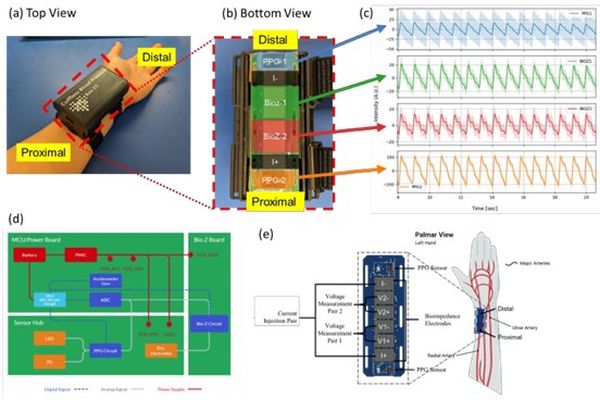Wrist Device Monitors Heart Rate and Blood Pressure
Outcome/Accomplishment
Research and development of a wearable wrist device that keeps track of the user’s vital cardiac signs has yielded a comfortable and effective design for commercial use. The measurements are a step up from traditional blood pressure readings and the device’s wearability enables ongoing monitoring, potentially saving lives. This research was supported by the U.S. National Science Foundation (NSF)-funded Precise Advanced Technologies and Health Systems for Underserved Populations (NSF PATHS-UP) Engineering Research Center (ERC), headquartered at TAMU, with partners from the University of California at Los Angeles, Rice University, and Florida International University.
Impact/Benefits
NSF PATHS-UP research aims to change the paradigm for the health of underserved populations by developing revolutionary and cost-effective technologies and systems at the point of care. The wrist device is specifically for use with chronic disease, which is a big challenge for underserved communities, leading to poor quality of life, high healthcare expenditures, and disability — even for younger people. This new system has proven the capability of multi-modal sensors in wearable form for daily, non-invasive ambulatory blood pressure monitoring.
Explanation/Background
Sensors for both Photoplethysmography (PPG) and bioimpedance (Bio-Z) signals are used together simultaneously in this multimodal system. PPG signals estimate blood pressure, while Bio-Z signals can detect blood pulsations in the wrist arteries and provide more accurate blood pressure readings. The device design is wireless with untethered capabilities, enabling data sampling at 10 KHz and storage on the device. Bluetooth communication facilitates data control and streaming.
The team went a step further and showed how a leg press machine could be used to vary an individual’s blood pressure, providing a valuable tool for device calibration.
Location
College Station, Texaswebsite
Start Year
Biotechnology and Healthcare
Lead Institution
Core Partners
Fact Sheet
Outcome/Accomplishment
Research and development of a wearable wrist device that keeps track of the user’s vital cardiac signs has yielded a comfortable and effective design for commercial use. The measurements are a step up from traditional blood pressure readings and the device’s wearability enables ongoing monitoring, potentially saving lives. This research was supported by the U.S. National Science Foundation (NSF)-funded Precise Advanced Technologies and Health Systems for Underserved Populations (NSF PATHS-UP) Engineering Research Center (ERC), headquartered at TAMU, with partners from the University of California at Los Angeles, Rice University, and Florida International University.
Location
College Station, Texaswebsite
Start Year
Biotechnology and Healthcare
Lead Institution
Core Partners
Fact Sheet
Impact/benefits
NSF PATHS-UP research aims to change the paradigm for the health of underserved populations by developing revolutionary and cost-effective technologies and systems at the point of care. The wrist device is specifically for use with chronic disease, which is a big challenge for underserved communities, leading to poor quality of life, high healthcare expenditures, and disability — even for younger people. This new system has proven the capability of multi-modal sensors in wearable form for daily, non-invasive ambulatory blood pressure monitoring.
Explanation/Background
Sensors for both Photoplethysmography (PPG) and bioimpedance (Bio-Z) signals are used together simultaneously in this multimodal system. PPG signals estimate blood pressure, while Bio-Z signals can detect blood pulsations in the wrist arteries and provide more accurate blood pressure readings. The device design is wireless with untethered capabilities, enabling data sampling at 10 KHz and storage on the device. Bluetooth communication facilitates data control and streaming.
The team went a step further and showed how a leg press machine could be used to vary an individual’s blood pressure, providing a valuable tool for device calibration.


